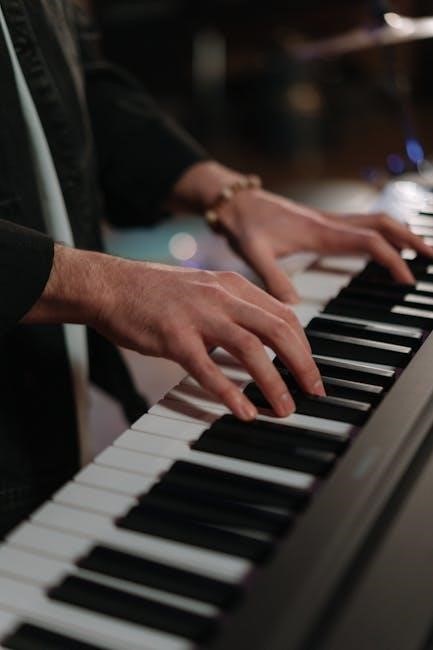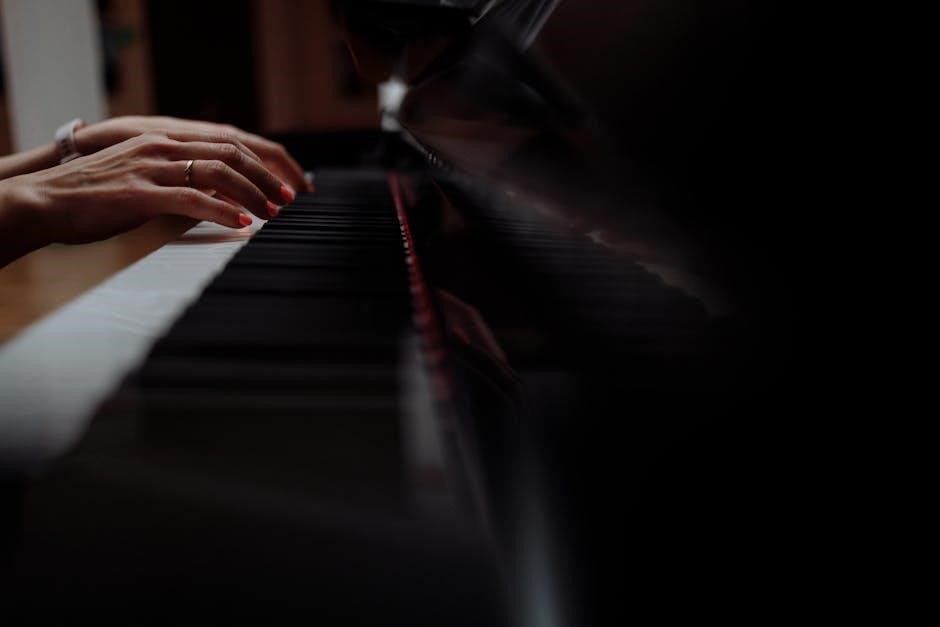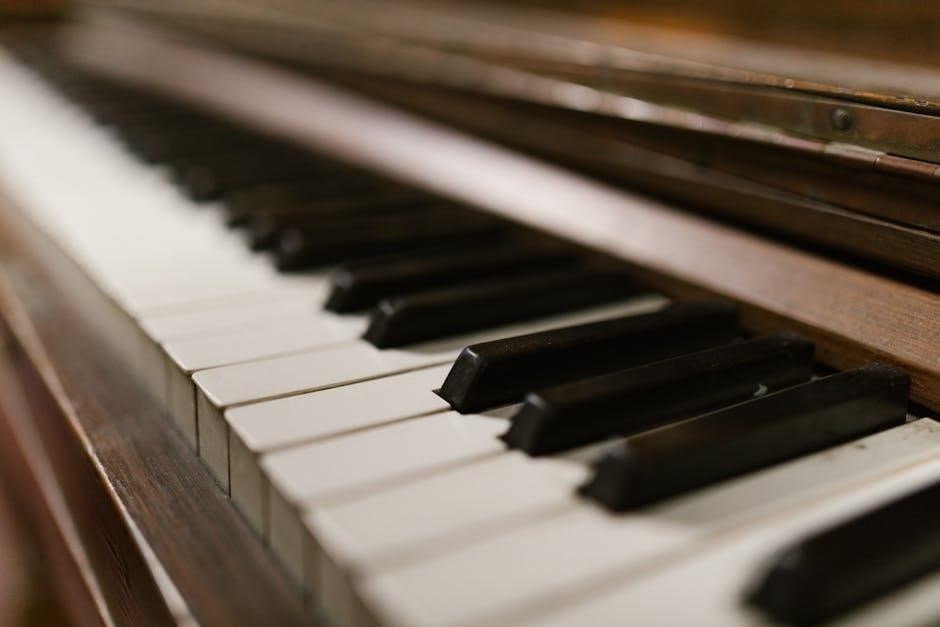hanon the virtuoso pianist pdf
Summary
Download Hanon the Virtuoso Pianist PDF and master piano techniques. Perfect for pianists of all levels!

“The Virtuoso Pianist” by Charles-Louis Hanon is a renowned piano exercise book containing 60 exercises to enhance finger strength, speed, precision, and wrist flexibility. This essential guide, available as a free PDF, is widely used by pianists to improve technique through scales, arpeggios, and complex finger movements. Its systematic approach has made it a cornerstone in piano education for over a century, ensuring mastery and artistry in piano performance.
Overview of the Book
“The Virtuoso Pianist” by Charles-Louis Hanon is a comprehensive guide containing 60 exercises designed to improve piano technique. It focuses on developing finger strength, speed, precision, and wrist flexibility through scales, arpeggios, and complex finger movements. The book is structured to progressively challenge pianists, making it suitable for both beginners and advanced players. Its systematic approach ensures mastery of essential skills, making it a foundational resource in piano education and practice.
Importance of the Exercises
The exercises in “The Virtuoso Pianist” are crucial for developing finger dexterity, strength, and wrist flexibility, essential for advanced piano techniques. They provide a structured approach to improving precision, speed, and agility, forming the technical foundation for mastering complex compositions. The exercises are widely regarded as indispensable for pianists, offering a comprehensive method to enhance overall pianistic skill and musical expression.
Structure of the PDF
The “Hanon The Virtuoso Pianist PDF” is a comprehensive collection of 60 exercises designed to improve piano technique. It includes scales, arpeggios, and other challenging pieces to enhance finger dexterity and strength. The PDF is available for free download from platforms like Musopen.org and is part of the IMSLP collection. With a file size of 323.5M, it provides pianists with a detailed and accessible resource for advancing their skills, added on August 21, 2012.

Background of Charles-Louis Hanon
Charles-Louis Hanon (1819-1900) was a French piano pedagogue and composer, best known for his ‘Virtuoso Pianist In 60 Exercises,’ which improves finger strength, precision, and wrist flexibility.
Biography of Charles-Louis Hanon
Charles-Louis Hanon was born on July 2, 1819, in Renescure, France, and died on March 19, 1900, in Boulogne-sur-Mer. A French piano pedagogue and composer, he is renowned for “The Virtuoso Pianist in 60 Exercises,” a foundational text in piano education. His work focuses on developing finger strength, speed, and dexterity, making it indispensable for pianists worldwide. Hanon’s legacy endures as a pioneer in piano pedagogy, shaping technical proficiency for generations of musicians.
Hanon’s Contribution to Piano Pedagogy
Charles-Louis Hanon revolutionized piano education with “The Virtuoso Pianist in 60 Exercises,” establishing a foundational method for technical mastery. His exercises focus on finger independence, strength, and precision, providing a systematic approach to piano training. Widely adopted by teachers and students, Hanon’s work remains a cornerstone of modern piano pedagogy, ensuring its enduring influence in shaping technical proficiency and artistic expression for pianists worldwide.
Historical Context of His Work
Charles-Louis Hanon’s “The Virtuoso Pianist” emerged in the 19th century, a period of significant advancement in piano technique. His exercises addressed the growing demand for structured pedagogical material, offering a systematic approach to technical mastery. Hanon’s work became integral to piano education, influencing generations of pianists and educators. Its enduring relevance reflects the timeless need for foundational technical training in classical music, solidifying its place in musical history.

The 60 Exercises: A Comprehensive Guide
Hanon’s 60 exercises offer a structured approach to piano technique, progressing from simple to complex. They enhance finger strength, dexterity, and accuracy, essential for classical pianists. Organized by technique, they cover scales, arpeggios, and finger independence, providing a clear path for skill development. The guide suggests a practice order, highlights benefits, and offers tips to avoid common mistakes, ensuring effective and disciplined practice. Historical context and pianist testimonials enrich the learning experience, while digital tools enhance accessibility, making it a versatile resource for all skill levels.
Understanding the Exercises
The exercises are meticulously designed to target specific technical challenges, fostering finger independence, strength, and dexterity. Each piece focuses on a particular technique, such as scales, arpeggios, or chromatic runs, with gradual increases in complexity. Understanding their purpose helps pianists approach them effectively, ensuring proper execution and musicality. The systematic progression from simple to intricate patterns prepares pianists for advanced repertoire, making them indispensable for technical mastery.
Benefits of Practicing the Exercises
Practicing Hanon’s exercises enhances finger strength, dexterity, and accuracy, while improving coordination and control. They strengthen weaker fingers and ensure evenness in playing. Regular practice boosts speed, precision, and endurance, essential for mastering complex repertoire. These exercises also enhance sight-reading skills and reduce fatigue during performances. Consistent practice fosters technical mastery, enabling pianists to approach challenging pieces with confidence and artistry.
Organization and Progression
The exercises are meticulously organized into groups, each focusing on specific techniques like scales, arpeggios, and chromatic patterns. They progress logically from simple to complex, ensuring a steady buildup of skill. This structured approach allows pianists to master foundational techniques before tackling advanced challenges, fostering a comprehensive and balanced technical development.

Technical Benefits of Hanon’s Exercises
Hanon’s exercises enhance finger strength, dexterity, and precision, while improving wrist flexibility and control. They systematically develop technical mastery, enabling pianists to perform complex pieces with ease and accuracy.
Improving Finger Strength and Dexterity
Hanon’s exercises are renowned for enhancing finger strength and dexterity through targeted finger independence routines. Each finger is systematically strengthened, improving evenness and control. The 60 exercises are designed to develop agility and coordination, benefiting pianists of all levels. Regular practice fosters muscular endurance, ensuring precise and expressive performances.
Enhancing Speed and Precision
Hanon’s exercises are highly effective for improving speed and precision, particularly through arpeggios and scales. These repetitive patterns train the fingers to move swiftly and accurately across the keyboard. By focusing on rhythm and timing, pianists develop the ability to play complex passages with clarity and control. Regular practice builds muscular memory, enabling faster and more precise performances over time.
Developing Wrist Flexibility
Hanon’s exercises emphasize wrist flexibility through dynamic finger movements and forearm rotations. The smooth transitions between notes require relaxed wrist articulation, preventing stiffness. Consistent practice improves the ability to execute wide jumps and intricate passages with ease. These exercises also strengthen wrist independence, essential for complex compositions, while promoting natural hand positioning to avoid injury and enhance overall technique.

Historical Significance of “The Virtuoso Pianist”
Hanon’s work laid the foundation for modern piano technique, establishing a standard for technical mastery. Its enduring influence has shaped piano education globally, remaining a cornerstone of classical training.
Publication and Reception
“The Virtuoso Pianist” was first published in 1873 in France, initially receiving mixed reviews. Critics praised its technical rigor but questioned its musicality. Despite early skepticism, the exercises gained popularity worldwide, becoming a cornerstone of piano education. By the early 20th century, Hanon’s work was widely adopted, solidifying its reputation as a foundational text for pianists seeking technical mastery.
Impact on Piano Education
“The Virtuoso Pianist” revolutionized piano education, establishing a standardized approach to technical training. Its systematic exercises became a cornerstone in conservatories and private lessons worldwide. Despite debates about its musicality, Hanon’s work remains a foundational tool, enabling pianists to achieve technical mastery. It has influenced generations of educators and shaped the way technical proficiency is taught and measured in piano pedagogy.
Evolution Over Time
First published in 1873, “The Virtuoso Pianist” has remained largely unchanged, yet its application has evolved. Modern pianists and educators adapt the exercises to suit contemporary techniques and musical interpretations. While the core exercises retain their original form, their integration with other methodologies reflects the dynamic nature of piano pedagogy, ensuring Hanon’s relevance in a changing musical landscape.

Pedagogical Approach in Hanon’s Work
Hanon’s method emphasizes systematic, progressive exercises to build technique. It focuses on repetition, gradual difficulty, and finger independence, fostering muscle memory and technical proficiency through structured practice.
Methodology and Philosophy
Hanon’s methodology revolves around a systematic approach to piano technique, emphasizing repetition and gradual progression. His philosophy centers on building a strong technical foundation through targeted exercises, ensuring finger independence, and fostering musical precision. By focusing on specific movements and patterns, Hanon’s exercises aim to create muscle memory and mastery of complex passages, reflecting his belief in the importance of technical proficiency as a basis for artistic expression.
Teaching Techniques
Hanon’s exercises employ targeted finger movements and repetitive patterns to isolate and strengthen specific techniques. Each exercise is designed to address particular challenges, such as finger independence or dexterity, through precise, deliberate practice. The exercises progress gradually, building from simple to complex movements, ensuring a comprehensive mastery of piano technique. This approach emphasizes consistency and precision, making it a foundational tool for piano education.
Application in Modern Teaching
Hanon’s exercises remain a cornerstone in modern piano instruction, offering a structured approach to technical mastery. Teachers often integrate the exercises into lesson plans, blending them with contemporary methods to enhance versatility. The PDF format allows easy access, enabling teachers to assign specific exercises digitally. Modern educators adapt Hanon’s techniques to suit individual needs, ensuring relevance in today’s diverse musical landscape while preserving foundational principles.
Digital Availability and Accessibility
The “Hanon The Virtuoso Pianist PDF” is widely available online, offering instant access to the exercises. Its digital format ensures compatibility with modern devices, making it easily accessible for pianists worldwide.
Downloading the PDF
Downloading “Hanon The Virtuoso Pianist PDF” is straightforward, with numerous websites offering free or paid versions. Ensure you use reputable sources to avoid malware. The PDF is widely available, and its digital format allows easy access on devices like tablets, smartphones, or computers. This convenience makes it a popular choice for pianists seeking to practice Hanon’s exercises without physical copies.
Popular Platforms for Access
“Hanon The Virtuoso Pianist PDF” can be accessed through various platforms. Google search often reveals free downloads from reputable sites. Amazon, eBay, and sheet music websites like Musicnotes and SheetMusicPlus offer both free and paid versions. Additionally, platforms like Piano Nanny and Scribd host the PDF, catering to pianists seeking convenient access to Hanon’s exercises for practice and study.
Advantages of the Digital Format
The digital format of “Hanon The Virtuoso Pianist PDF” offers convenience and accessibility. It allows instant access across devices, eliminating the need for physical storage. The PDF can be easily shared, annotated, and zoomed for readability. Additionally, digital versions often include search functions and navigation tools, making it simpler to locate specific exercises. This format is ideal for modern pianists seeking flexibility and efficiency in their practice routine.

Practical Tips for Mastering Hanon’s Exercises
Set clear goals, practice consistently, and focus on proper hand positioning. Start slowly, build speed gradually, and incorporate relaxation techniques to enhance finger dexterity and overall technique effectively.
Practice Routine and Discipline
Establish a consistent daily practice schedule, dedicating 15-30 minutes to Hanon exercises. Set specific goals for each session, such as mastering a difficult passage or improving finger independence. Begin with slower tempos to ensure accuracy, gradually increasing speed as mastery grows. Incorporate warm-ups and stretches to prevent fatigue and injury, fostering long-term progress and discipline in your pianistic development.
Common Mistakes to Avoid
Avoid rushing through exercises without proper technique, as this can lead to poor finger habits. Neglecting dynamics and articulation reduces musicality. Playing too loudly strains hands and wrists. Skipping warm-ups increases injury risk. Don’t overlook gradual tempo increases; start slow and build speed. Ignoring finger independence exercises hinders progress. Prioritize precision over speed to ensure proper muscle memory development and long-term mastery of Hanon’s exercises effectively.
Integrating Hanon into Daily Practice
Start with a few exercises daily, gradually increasing difficulty. Balance Hanon with repertoire to avoid monotony. Prioritize proper technique and dynamics. Use a metronome to build accuracy and speed. Incorporate warm-ups and stretches to prevent fatigue. Set specific goals for each session, like mastering a challenging passage. Consistency is key; even short, focused practice yields progress. Make Hanon a foundational part of your routine for lasting improvement.
Comparison with Other Piano Exercise Books
Hanon’s systematic approach and variety of exercises provide a comprehensive technical foundation, complementing other methods like Czerny or Dohnányi, while offering unique focus on finger dexterity.
Similarities and Differences
Hanon’s exercises share similarities with other piano method books like Czerny and Dohnányi in their focus on technical mastery. However, Hanon’s unique systematic approach, with its emphasis on finger independence and dexterity, sets it apart. While other methods may prioritize musicality or repertoire, Hanon’s exercises are renowned for their versatility and foundational benefits, making them a cornerstone in piano education.
Unique Features of Hanon’s Exercises
Hanon’s exercises are distinguished by their systematic approach to finger independence, strength, and dexterity. Each exercise targets specific fingers or groups, fostering uniformity and precision. The progressive difficulty and repetitive patterns ensure gradual mastery. Unlike other methods, Hanon’s focus is purely technical, with exercises designed to build a strong foundation. This comprehensive system has made it a cornerstone in piano education for over a century.
When to Use Hanon vs. Other Methods
Hanon’s exercises are ideal for building foundational technique, especially for beginners or those refining finger independence. They excel in developing strength, precision, and dexterity. However, for expressive or repertoire-focused practice, other methods may be more suitable. Use Hanon during early training or technical refinement, while incorporating other approaches for musicality and stylistic interpretation. This balanced approach ensures well-rounded piano development.

Expert Opinions and Reviews
Renowned pianists and educators consistently praise Hanon’s exercises for their technical benefits. Many, like Lang Lang and Murray Perahia, consider them essential for building finger strength and precision. While some suggest integrating Hanon with other methods for a well-rounded approach, its foundational role in piano education remains undisputed.
Feedback from Renowned Pianists
Pianists like Lang Lang and Maurizio Pollini have praised Hanon’s exercises for their technical rigor. Many virtuosos, including Murray Perahia, emphasize their importance in developing finger independence and strength. However, some pianists advocate for a balanced approach, combining Hanon with repertoire to avoid mechanical playing. Despite debates, the exercises remain a cornerstone in pianistic training, widely recommended by leading performers and educators for their foundational benefits.
Reviews from Piano Teachers
Piano teachers widely endorse Hanon’s exercises for their ability to build technical mastery. Many educators highlight their effectiveness in improving finger independence, strength, and control. While some teachers caution against overuse, they agree that the exercises provide a solid foundation. Teachers often incorporate Hanon into lessons, praising its structured approach. However, they emphasize the importance of balancing technical drills with musical repertoire to avoid monotony and ensure well-rounded development.
Student Experiences and Testimonials
Students often describe Hanon’s exercises as challenging yet rewarding. Many report noticeable improvements in finger dexterity and technical precision after consistent practice. While some find the repetition demanding, most appreciate the structured approach. Testimonials highlight enhanced control and confidence in performances. Students emphasize the importance of discipline and patience, calling Hanon’s exercises a cornerstone of their piano mastery journey.

Cultural and Educational Impact
Hanon’s exercises revolutionized piano education, setting a global standard for technical mastery. Their systematic approach has influenced generations, shaping piano pedagogy and cultural expectations of virtuosity.
Influence on Piano Education Worldwide
Hanon’s exercises have become a cornerstone in piano education globally, adopted by conservatories and teachers worldwide. Their structured approach to technique has standardized training, ensuring consistency and excellence. Translated into multiple languages, the PDF remains a universal resource, bridging cultural and educational gaps, and empowering pianists across continents to achieve technical mastery and artistic expression.
Cultural Significance in Music History
Hanon’s “The Virtuoso Pianist” holds a revered place in music history, shaping the technical foundations of piano playing. Its universal adoption across cultures has made it a cornerstone of classical music education. The PDF’s accessibility has ensured its enduring relevance, inspiring generations of pianists and influencing the evolution of piano technique worldwide, cementing its legacy as a timeless musical resource.
Role in Shaping Piano Technique
Hanon’s exercises have profoundly influenced piano technique, establishing a foundation for finger strength, dexterity, and precision. The systematic approach of the PDF has set a standard for technical proficiency, emphasizing finger independence and control. By addressing specific technical challenges, Hanon’s work has shaped modern piano pedagogy, enabling pianists to master complex repertoire with ease and precision, making it indispensable for aspiring musicians.
Hanon’s “The Virtuoso Pianist” remains a cornerstone of piano education, offering timeless exercises that refine technique and artistry. Its enduring relevance ensures its essential role in shaping pianists worldwide.

Hanon’s “The Virtuoso Pianist” is a foundational guide for pianists, offering 60 exercises to enhance technical mastery. It focuses on finger strength, dexterity, and precision, while promoting musicality. The book’s structured approach ensures progressive skill development, making it a cornerstone in piano education. Its timeless relevance and digital accessibility continue to inspire pianists worldwide, solidifying its legacy as a vital resource for aspiring musicians of all levels.
Final Thoughts on Hanon’s Legacy
Hanon’s “The Virtuoso Pianist” remains a cornerstone of piano education, shaping technique and artistry for generations. Its exercises, though challenging, offer unparalleled benefits for finger dexterity and musical precision. As a timeless resource, Hanon’s work continues to inspire pianists, bridging traditional and modern methods. Its enduring legacy underscores its importance as a foundational tool for achieving mastery and artistry at the piano.
Encouragement for Aspiring Pianists
Hanon’s exercises are a powerful tool for growth, but remember, mastery takes time. Embrace the journey, and don’t be discouraged by challenges. Consistent practice will unlock technical skill and musical artistry. Balance rigor with joy, and celebrate small victories. Stay patient, persistent, and passionate. Every effort brings you closer to your goals, and the legacy of Hanon’s work will guide you toward pianistic excellence.